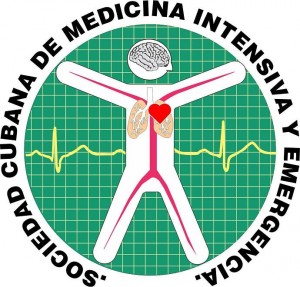Behavior of the nosocomial infections in an intensive care unit
Keywords:
nosocomial infections, behaviour, germsAbstract
Introduction: Nosocomial infections in intensive care units is not a new issue, but it is of growing concern worldwide and especially at present times.
Objective: To describe the behavior of nosocomial infections in an intensive care unit.
Methods: A descriptive, longitudinal and prospective study was carried out in the Intensive Care Unit at “Manuel Ascunce Domenech” University Provincial Hospital, in Camagüey, from 2017 to 2019. The sample was represented by 214 patients. Variables such as age, sex, diagnosis on admission, associated comorbidities, risk factors, location of the nosocomial infection, hospital stay, isolated germs, group of antibiotics used in the initial treatment and the status at discharge were analyzed. The SPSS 19.0 statistical program was used for data processing and descriptive statistics for the analysis of the variables.
Results: The male sex and the age group of 61 and 75 years predominated. Sepsis and septic shock were the main diagnoses on admission, followed by cerebrovascular diseases and major abdominal surgeries. Among the major comorbidities were arterial hypertension and diabetes mellitus. The most common locations of infections were in the lung and urinary tract. The isolates were mostly from Acinetobacter baumannii, Enterobacter gergoveae and E. coli. There was a low percentage of deaths.
Conclusions: Nosocomial infections predominated in males and in the age group older than 60 years. Sepsis and septic shock were the main reason for admission, almost always based on nosocomial pneumonia as the most frequent site of infection. The main comorbidity was arterial hypertension. Invasive procedures and prolonged hospital stay prevailed as risk factors. The germ that was most isolated was Acinetobacter baumannii.
Downloads
References
1. Shah TA, Pai V, Devrari JC. Efficacy of Procalcitonin as a Marker of Acute Inflammation in Patients of Suspected Bacterial Sepsis. Int J Curr Microbiol App Sci. 2016 [citado: 16/05/2020];5(10):533-6. Disponible en: http://www.ijcmas.com/5-10-2016/Tariq%20Ahmad%20Shah,%20et%20al.pdf
2. Hernández Palazón J, Fuentes García D, Burguillos López S, Domenech Asensio P, Sansano Sánchez TV, Acosta Villegas F. Análisis de la insuficiencia de órganos y mortalidad en la sepsis por peritonitis secundaria. Med Intensiva. 2018 [citado: 16/05/2020];37(7):461-7. Disponible en: http://www.medintensiva.org/es/analisis-insuficiencia-organos-mortalidad-sepsis/articulo/S0210569112002501/.
3. Cerda Cortaza JL, López Reyna MA. Resultados de la reanimación preoperatoria en sepsis grave y choque séptico en pacientes con infección intraabdominal. Cir Gen. 2017 [citado: 16/05/2020];36(4):199-204. Disponible en: http://www.elsevier.es/es-revista-cirujano-general-218-pdf-X1405009914739699-S300.
4. MINSAP. Anuario Estadístico de Salud 2016. Cuba: MINSAP; 2017.
5. Rodríguez B, Iraola M, Molina F, Pereira E. Infección hospitalaria en la Unidad de Cuidados Intensivos Polivalente de un hospital universitario cubano. Rev Cub Invest Bioméd. 2006 [citado: 16/05/2020];25(3). Disponible en: http://scielo.sld.cu/scielo.php?script=sci_arttext&pid=S0864-03002006000300003
6. Suárez OV. ¿Puede ser prevenida la disfunción endotelial en el paciente crítico? Rev Cub Med Int Emerg. 2015 [citado: 16/05/2020];14(4):82-9. Disponible en: http://www.revmie.sld.cu/index.php/mie/article/view/119/221
7. Rodríguez-Montoya R, Sandoval-Oliva V, Cabrejo-Paredes J, Chacón-Angulo N, Chinquinta-Ramos G, Rodríguez-Montoya M. Variables asociadas a costos en Cuidados intensivos. Rev Asoc Méx Med Crít y Terap. Inten. 2015 [citado: 16/05/2020];29(3). Disponible en: http://www.mediagraphic.com/pdfs/medcri/ti-2015/ti153c.pdf
8. Henriksen DP, Laursen CB, Jensen TG. Incidence rate of community acquired sepsis among hospitalized acute medical patients – a population – based survey. Crit Care Med. 2015 [citado: 16/05/2020];43:13-21. Disponible en: https://www.ncbi.nlm.nih.gov/m/pubmed/25251760
9. Alebachew G, Teka B, Endris M, Sheiferaw Y, Tessema B. Etiologic Agents of Bacterial Sepsis and their antibiotic susceptibility patterns among patients living with human immunodeficiency virus at Gondar University Teaching Hospital, Northwest Ethiopia. Biomed Research International. 2016 [citado: 16/05/2020]. Disponible en: https://www.hindawi.com/journals/bmri/2016/5371875/abs/
10. Kelly B, Lautenbach E, Nachamkin I, Coffin S, Gerber J, Fuchs B, et al. Combined biomarkers discriminate a low likelihood of bacterial infection among surgical intensive care unit patients with suspected sepsis. Diagn Microbiol and Infect. Dis. 2016 [citado: 16/05/2020];85(1):109-15. Disponible en: http://www.sciencedirect.com/science/article/pii/S0732889316000043
11. Morillo-García A, Aldana-Espinal JM, Olry de Labry-Lima A, Valencia-Martín R, López-Márquez R, Loscertales-Abril M, et al. Hospital costs associated with nosocomial infections in a pediatric intensive care unit. Gac Sanit. 2015 [citado: 16/05/2020];29(4):282-7. Disponible en: http://scielo.isciii.es/scielo.php?script=sci_arttext&pid=S0213-91112015000400007&Ing=es.
12. Vincent JL, Bihari DJ, Suter PM, Bruining HA, White J, Nicholas-Chanoin MH. The prevalence of nosocomial infection in Intensive Care Units in Europe. Results of the European Prevalence of Infection in Intensive Care (EPIC) study. JAMA. 1995 [citado: 16/05/2020];274:639-44. Disponible en: https://www.ncbi.nlm.nih.gov/pubmed/7637145
13. Vincent JL, Rello J, Marshall J, Silva E, Anzueto A, Martin CD. EPIC II Group of Investigators International study of the prevalence and outcomes of infection in intensive care units JAMA. 2009;302:2323-29. Disponible en: http://dx.doi.org/10.1001/jama.2009.1754
14. Pertuz-Meza Y, Pérez-Quintero C, Pabón-Varela Y. Aspectos epidemiológicos de la sepsis, en unidades de cuidados intensivos Santa Marta, Colombia. Duazary. 2016 [citado: 17/05/2020];13(2):126-32. Disponible en: http://revistas.unimagdalena.edu.co/index.php/duazary/article/view/1718/1215
15. Freund Y, Lemachatti N, Krastinova E, Van Laer M, Claessen YE, Avondo A, et al. Prognostic Accuracy of Sepsis-3 Criteria for In-Hospital Mortality Among Patients with Suspected Infection Presenting to the Emergency Department. JAMA. 2017 [citado: 17/05/2020];317(3):301-8. Disponible en: https://www.ncbi.nlm.nih.gov/pubmed/28114554
16. Raith EP, Udy AA, Bailey M, McGloughlin S, Maclsaac C, Bellomo R, et al. Prognostic Accuracy of the SOFA Score, SIRS Criteria, and qSOFA Score for In-Hospital Mortality Among Adults with Suspected Infection Admitted to the Intensive Care Unit. JAMA [citado: 17/05/2020];317(3):290-300. Disponible en: https://www.ncbi.nlm.nih.gov/pubmed/28114553
17. Carey IM, Critchley JA, DeWilde S, Harris T, Hosking FJ, Cook DG. Risk of Infection in Type 1 and Type 2 Diabetes Compared with the General Population: A Matched Cohort Study. Diabetes Care. 2018 [citado: 17/05/2020];41(3):513-21. Disponible en: https://www.ncbi.nlm.nih.gov/pubmed/29330152
18. Artero A, Inglada L, Belda AG, Capdevila J, Diez LF, Arca A, et al. The clinical impact of bacteremia on outcomes in elderly patients with pyelonephritis or urinary sepsis: A prospective multicenter study. PLoS One. 2018 [citado: 17/05/2020];13(1):e0191066. Disponible en: https://www.ncbi.nlm.nih.gov/pubmed/29364923
19. Baggs J, Jernigan JA, Halpin AL, Epstein LH, Hatfield KM, McDonald LC. Risk of Subsequent Sepsis within 90 Days of a Previous Hospital Stay by Type of Antibiotic Exposure. Clin Infect Dis. 2017 [citado: 17/05/2020];66(7):1004-12. Disponible en: https://www.ncbi.nlm.nih.gov/pubmed/29136126
20. Zaragoza R, Ramírez P, López-Pueyo M. Infección nosocomial en las unidades de cuidados intensivos. Enferm Infecc Microbiol Clin. 2015 [citado: 17/05/2020];32:320-7. Disponible en: http://www.elsevier.es/es-revista-enfermedades-infecciosas-microbiologia-clinica-28-articulo-infeccion-nosocomial-las-unidades-cuidados-S0213005X14000597
21. Almasaudi SB. Acinetobacter spp. as nosocomial pathogens: Epidemiology and resistance features. Saudi J Biol Sci. 2018 Mar [citado: 17/05/2020];25(3):586-96. Disponible en: https://www.ncbi.nlm.nih.gov/pubmed/29686523
22. Gupta N, Soneja M, Ray Y, Sahu M, Vinod KS, Kapil A, et al. Nosocomial pneumonia: Search for an empiric and effective antibiotic regimen in high burden tertiary care center. Drug Discov Ther. 2018 Apr 17 [citado: 17/05/2020];12(2):97-100. Disponible en: https://www.ncbi.nlm.nih.gov/pubmed/29669956
23. Baykara N, Akalin H, Arslantas MK, Hanci V, Caglayan C, Kahveci F, et al. Epidemiology of sepsis in intensive care units in Turkey: a multicenter, point-prevalence study. Crit Care. 2018 Apr 16 [citado: 17/05/2020];22(1):93. Disponible en: https://www.ncbi.nlm.nih.gov/pubmed/29656714
24. Labi AK, Obeng NN, Owusu E, Bjerrum S, Bediako BA, Sunkwa MG, et al. Multi-centre point prevalence survey of hospital-acquired infections in Ghana. J Hosp Infect. 2019 Ene [citado: 17/05/2020];101(1):60-8. Disponible en: https://www.ncbi.nlm.nih.gov/pubmed/29730140
25. de Léotoing L, Barbier F, Dinh A, Breilh D, Chaize G, Vainchtock A, et al. French hospital discharge database (PMSI) and bacterial resistance: Is coding adapted to hospital epidemiology? Med Mal Infect. 2018 Oct [citado: 17/05/2020];48(7):465-73. Disponible en: https://www.ncbi.nlm.nih.gov/pubmed/29673880






